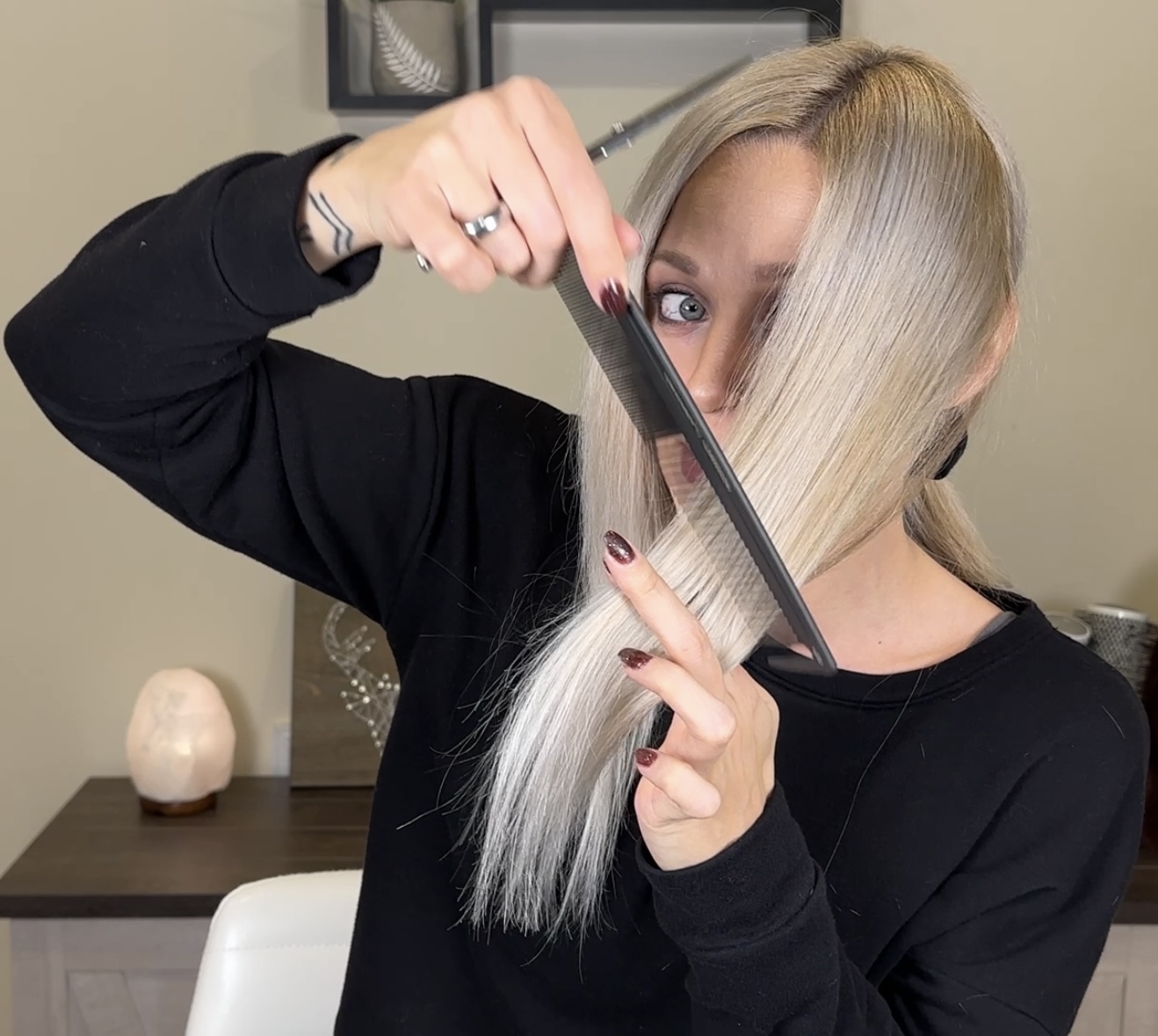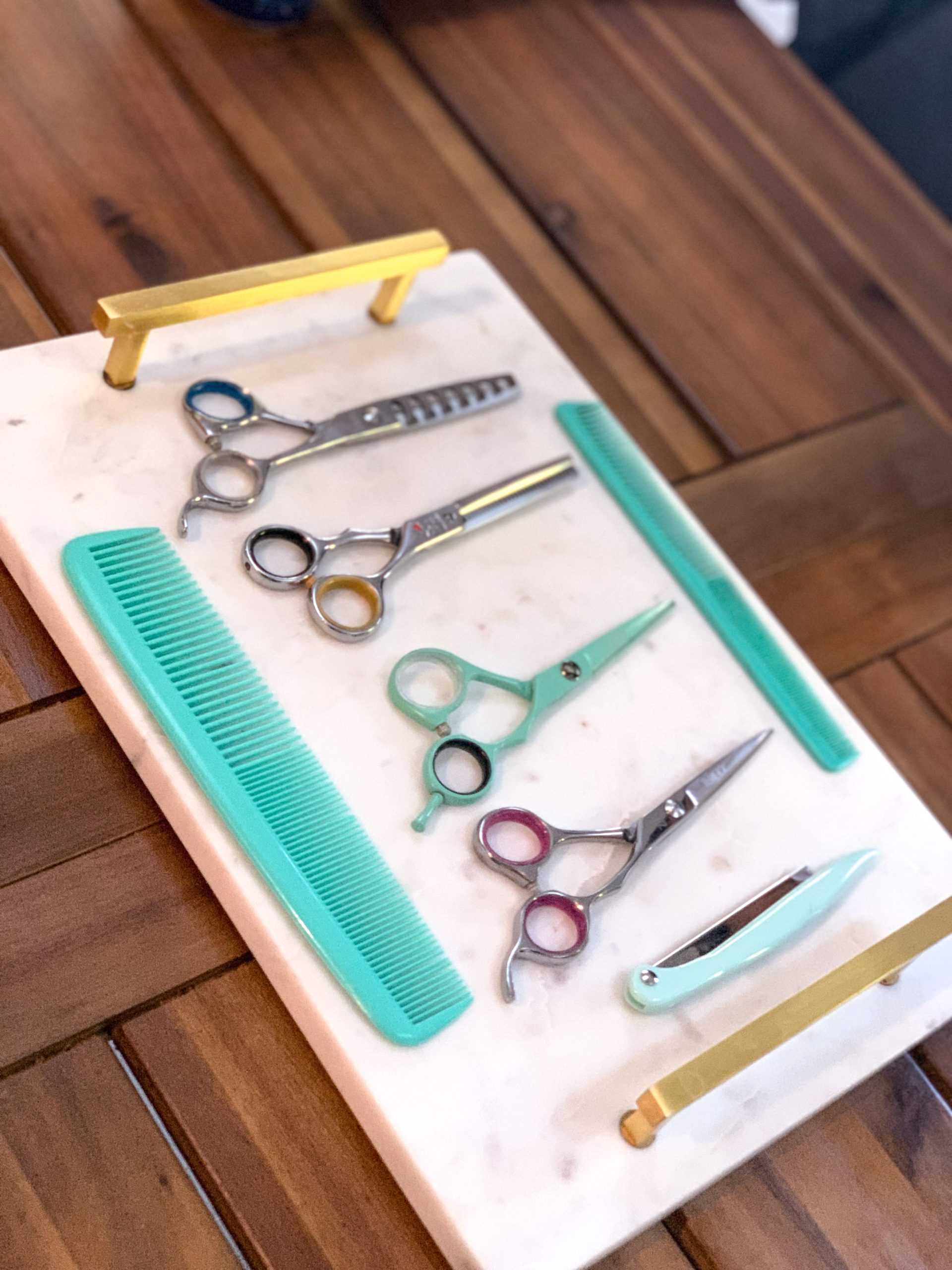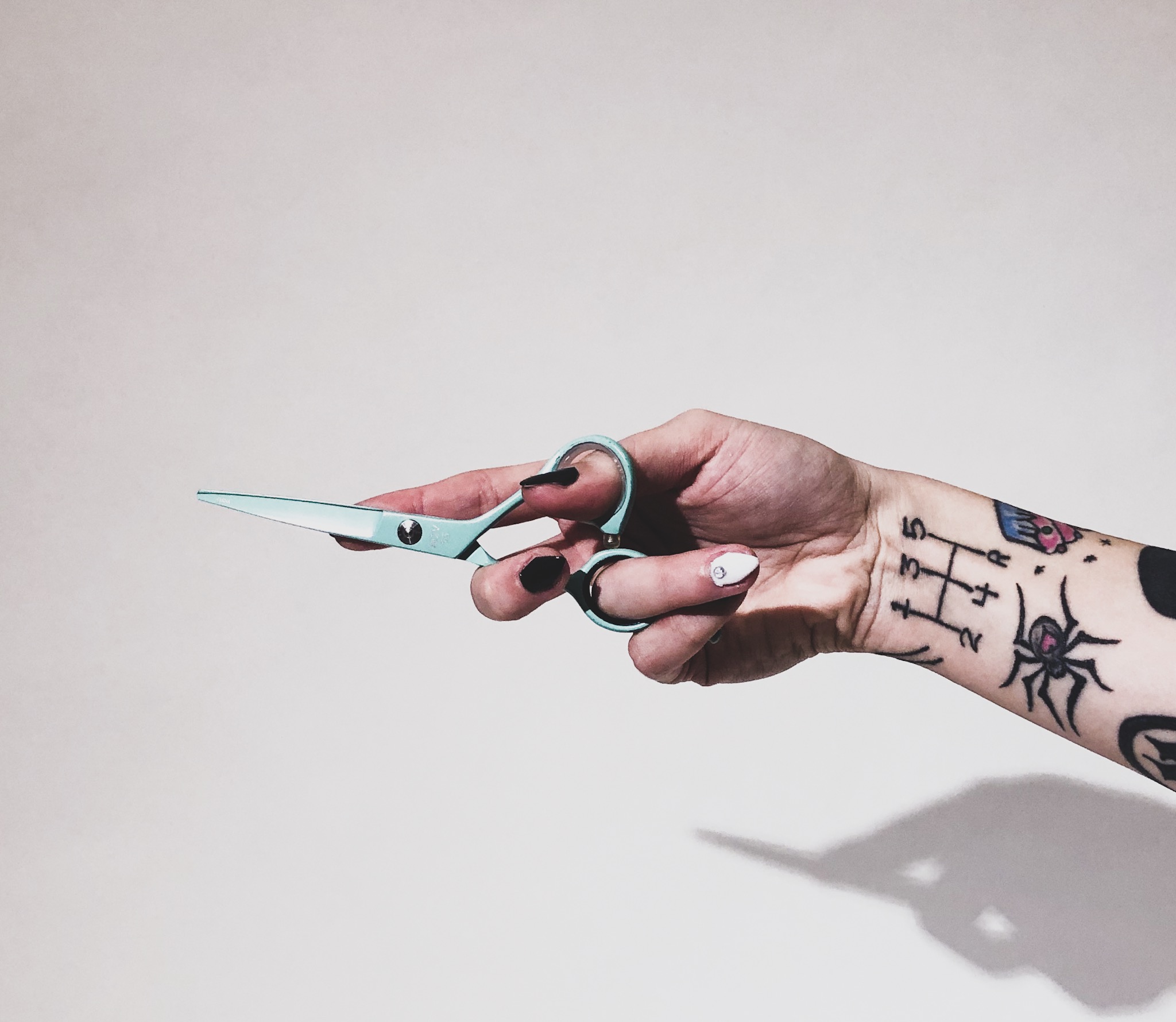
Is It Better To Cut Hair Wet Or Dry?
Have you ever wondered about the differences between cutting hair wet vs. dry? Which is ultimately better for your hair? Realistically, both options have their advantages and disadvantages based on the specific circumstances of the cut. So in this blog post, I’m going to cover the pros and cons of cutting the hair wet verse dry, as well as what situations are best for each style of cutting.
In my opinion, it is actually best to cut the hair both wet AND dry. But keep reading to find out why this is the case and how this should be done.
The Pros To Wet Hair Cutting

1. Wet hair gives you better control over the haircut
Wet hair will clump together which makes it easier to cut than if the hair was dry and spreading out or staticky. This makes it easier to achieve precise lines. Dry hair has more movement, so it’s not as easy to control.
This is especially true if you are cutting off a significant amount of hair or are looking for a very blunt cut. You need to have optimal control over the hair and don’t want any pieces to be out of place.
2. You can cut larger sections when the hair is wet
When the hair is wet, you can cut larger sections at a time because it’s clumped together. It doesn’t move or bend with the scissors with a large section of hair as much as it would with dry hair.
This is also dependent on how sharp the scissors are, but I do find that it’s easier to cut more hair at a time when the hair is wet than when it’s dry.
3. Razor cuts NEED wet hair
When it comes to razor cuts, the hair NEEDS to be wet. If you attempt to use a feather razor on dry hair, it can end up splitting the hair, making it frizzy and actually creating damage.
When I’m doing a razor cut, I often continuously spray the hair to keep it wet and the porosity even.
4. Water lubricates the cut
The water also helps to lubricate the connection between the hair and the scissors for a smoother cut. You may have noticed that when you cut dry hair, it can actually have a crunchy sound, especially if the hair is coarse or damaged.
Who wet cuts are best for
- Blunt cuts
- Razor cuts
- Transformation cuts
The Cons To Cutting Wet Hair
1. Hair shrinks as it dries
When your hair is wet, it’s being weighed down by water. The hair strands actually stretch when they’re wet and combed down. The amount that the stretches is dependent on the elasticity of your hair.
Because of this, your hair will always look longer when it’s wet. If your hairstylist cuts your hair to chin-length when it’s wet, it will be laying above your chin when it’s dry.
Wet hair also lacks volume. Volume is achieved by hair strands climbing on top of one another, and this doesn’t happen when they are absorbed with water and weighed down. So when your hair dries, not only does it shrink, but volume is achieved which lifts the pieces up even more.
2. You can’t see the wave pattern of wet hair
When curly hair is wet, it’s weighed down, which stretches out the curls. Curly hair can shrink SIGNIFICANTLY when it dries. I’m talking 50% and above.
This can also be a problem for the shape of the haircut when it’s dry. The hair will not be in its natural wave pattern when wet, so the wave pattern of the hair definitely needs to be considered here.
If the hair is wavy or curly, you can’t see how each curl or section of hair will lay when it does dry out.
3. It is easier to take too much off when the hair is wet
So when the hair is wet, you can’t properly see the split ends and what all needs to come off. This is because the hair is clumped together and absorbed with water, so the cuticle is lying smooth.
This means that if you didn’t already decide how much you need to take off when the hair was dry, than you’re just guessing when it’s wet. When cutting wet hair, you’re more likely to take more off than the bare minimum.
4. You can’t properly texturize wet hair
Texturizing is the process of removing bulk to reduce weight lines and add movement into the hair. This helps to adjust the shape of the hair and affects how it lays.
And when the hair is wet, you can’t see how it’s going to lay when it’s dry. You also can’t make the proper cuts on wet hair to texturize because it’s clumped together. You can try to do this with thinning shears, but you’ll likely create lines in the hair and will see every cut.
While there may be some hair stylists out there that prefer to texturize with a razor on wet hair. But in my opinion, this is dangerous. You are so much more likely to take large chunks off and absolutely butcher someone’s hair when using this method.
The Pros to Cutting Dry Hair

1. You can take a very minimal amount off of dry hair
When someone comes in wanting a trim or the bare minimum cut off, I always opt to cut the hair dry. When the hair is dry, you can easily see the split and frayed ends that need to go. And it’s much easier to only take off those frizzy pieces when the hair is dry.
I call these haircuts “pretend haircuts” because it’s trimming the hair without it looking like it was cut. Often times the hair looks longer, or at least fuller after one of these haircuts!
2. You can easily texturize and detail dry hair
As I mentioned above, it’s not easy to texturize wet hair. So if your stylist cuts your hair wet and sends you out the door with wet hair, it’s my recommendation that you find a new stylist.
The hair ALWAYS needs to be checked dry. You can cut dry hair without checking it wet, but you cannot cut wet hair without checking it dry.
When the hair is dry, the weight lines become visible. When there is too much weight or bulk in a section of hair, it needs to be texturized out. This can also be referred to as detailing the hair.
I often use 3 different types of scissors when doing this part of the haircut. This is how you create texture, movement, and whispy pieces in the hair.
One side of the hair may also have more volume than the other side based on the way it grows out of the scalp. So you always need to check how the sides are laying dry. You may need to cut one side technically shorter than the other because it naturally has less volume than the other side.
3. You can see the wave pattern of dry hair
When the hair is dry and in its natural state (not ironed), the natural wave pattern becomes visible. If you have curly hair and only wear your hair curly, than having your hair cut dry can be beneficial to the shape of your cut.
The hair stylist will likely go into your curls and start making cuts to shape and form the hair. If the hair was pulled out straight, the ends of the hair would be incredible uneven. But when it’s in its natural curly state, it looks uniform.
4. Dry cut only appointments are often quicker and cheaper
If you get a dry cut only appointment, you are likely able to save some time and money. If the hair isn’t shampooed and blow dried, you’ll be in and out in about 20 minutes or so.
Now, I only recommend this in between regular haircut appointments as I do believe the hair does need to get a good wet cut from time to time. But not for maintenance trims.
Keep in mind that if you go to a dry-cut-only appointment your hair should be clean and dry when you come in so that your hair stylist can easily go in and cut your hair without needing to wash and dry it first.
Who dry cuts are best for
- Minimal trims
- Texturizing
- Curly hair
4 Cons to Cutting Dry Hair
1. It can be difficult to get precise lines on a dry cut only
As we mentioned earlier, you have to be more careful with precision when dry cutting. This is different than detailing, as detailing is often done with point cutting.
Cutting a blunt line is just way easier when the hair is wet. The hair doesn’t move as much, so you can get that precise blunt line when the hair is cut wet.
2. Your hair can get damaged if not done properly
If your shears are not sharp enough or you attempt to perform a razor cut on dry hair, you can severely damage your hair. The hair can get caught in the feather razor, stretch and split when you attempt to cut it dry.
When the hair is dry it’s more likely to rip and tear the hair, and when it’s wet it will slide along the hair better because it’s lubricated with water.
3. Dry cutting is not ideal for transformation haircuts
If you are taking off significant length, I would highly recommend doing the first part of the haircut wet, and then go back and detail it dry.
It would take you nearly twice as long to perform the cut dry (since you have to take smaller sections when the hair is dry), and it likely wouldn’t lay right.
4. You have less control when cutting dry hair
Dry hair is not controlled as easily as wet hair is. When the hair clumps together it is easier to cut larger sections as well as make each cut with precision and little movement.
You’ll have to deal with more static and flyaways when cutting dry hair opposed to the control that you get from working with wet hair.
Conclusion
At the end of the day, I cut 90% of my clients both wet AND dry. And there are times when I solely do dry cutting only, it all depends on the circumstance and when the last time was they had a wet cut. But I never recommend cutting the hair wet only without also checking it dry.
Wet cutting advantages
- More control
- Can take larger sections
- Razor cuts need wet hair
- Water lubricates the cut
Wet cutting disadvantages
- Hair shrinks as it dries
- It is easier to take off too much on accident
- You can’t properly texturize wet hair
- The wave pattern is stretched out
Dry cutting advantages
- Better for trims and minimal cuts
- Optimal for texturizing and detailing
- You can see the natural wave pattern
- Quicker and cheaper appointments
Dry cutting disadvantages
- Not as precise for blunt cuts
- Easier to get damaged
- Not ideal for transformation cuts
- Less control
If you enjoyed this, take a look at some other posts I’ve written about haircutting:
- How Frequently You Should Really Get Your Hair Cut
- A Trim Is The Same As A Haircut
- How To Differentiate Texturizing, Layers, And Thinning
- Will A Razor Cut Be Good For My Hair?
If you have any further questions for me on this topic, be sure to leave them for me in the comment section. Subscribe below to Have A Good Hair Day!


